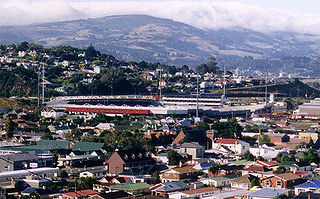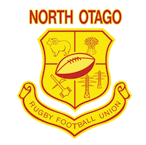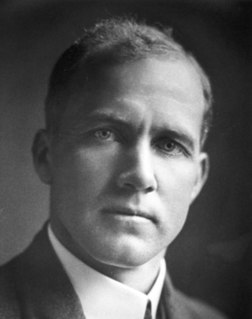
Oamaru is the largest town in North Otago, in the South Island of New Zealand, it is the main town in the Waitaki District. It is 80 kilometres (50 mi) south of Timaru and 120 kilometres (75 mi) north of Dunedin on the Pacific coast; State Highway 1 and the railway Main South Line connect it to both cities. With a population of 13,850, Oamaru is the 28th largest urban area in New Zealand, and the third largest in Otago behind Dunedin and Queenstown. The town is the seat of Waitaki District, which includes the surrounding towns of Kurow, Weston, Palmerston and Hampden. which combined have a total population of 23,200

Carisbrook was a major sporting venue in Dunedin, New Zealand. The city's main domestic and international rugby union venue, it was also used for other sports such as cricket, football, rugby league and motocross. In 1922, Carisbrook hosted the very first international football match between Australia and New Zealand. The hosts won 3-1.

The Otago cricket team are a New Zealand first-class cricket team formed in 1864 representing the Otago, Southland and North Otago regions. Their main governing board is the Otago Cricket Association which is one of six major associations that make up New Zealand Cricket.

The Otago Rugby Football Union is the official governing body of rugby union for the Otago region of New Zealand. The union is based in the city of Dunedin, and its home ground is Forsyth Barr Stadium. The top representative team competes in the ITM Cup, New Zealand's top provincial competition. The union was to have been liquidated in March 2012. However a deal involving the Dunedin City Council allowed it to keep operating. Otago have won the Ranfurly Shield on seven occasions. They were the National provincial championship winners in 1991 and 1998. They have a proud record playing international teams, having defeated South Africa and the British and Irish Lions.

The North Otago Rugby Football Union (NORFU) is a New Zealand rugby union province based in Oamaru and compete in the Heartland Championship. They are one of the strongest teams in The Heartland Championship, winning the Meads Cup section of the competition in its second year, 2007 as well as 2010. Their home ground is Whitestone Contracting Stadium, formerly Centennial Park.

Centennial Park is a sports complex on Taward Street in Oamaru. The main sports played there are rugby union, cricket, and hockey. In 2007, the main ground was renamed Whitestone Contracting Stadium, after naming rights were granted to Whitestone Contracting Limited.

An English team raised by the Marylebone Cricket Club (MCC) toured New Zealand between December 1906 and March 1907. The tour comprised two first-class matches against New Zealand, two each against the four main provincial teams – Auckland, Canterbury, Otago and Wellington – and one against Hawke's Bay. There were also five minor matches against teams from country areas.

Alexander Dalziel Downes was a noted sportsman at rugby and cricket, at which he represented New Zealand.

The Hawke Cup is a non-first-class cricket competition for New Zealand's district associations. Apart from 1910–11, 1912–13 and 2000–01 the competition has always been on a challenge basis. To win the Hawke Cup, the challengers must beat the holders, either outright or on the first innings in a drawn match, on the holders' home ground.
This article describes the history of New Zealand cricket from the 1945–46 season until 1970.

The Otago Sparks is the women's representative cricket team for the New Zealand region of Otago and the surrounding area. They play their home games at University Oval, Dunedin. They compete in the Hallyburton Johnstone Shield one-day competition and the Women's Super Smash Twenty20 competition.
The Australia national cricket team toured New Zealand from February to April 1914 and played eight first-class matches including two against the New Zealand national team. New Zealand at this time had not been elevated to Test status. The tour was organized and captained by Arthur Sims, who had previously represented New Zealand. The tour is notable for the fact that it featured Victor Trumper's final appearance in a first-class match before his death at age 37 in 1915.
Southland are a cricket team representing the Southland Region of New Zealand. They compete in the Hawke Cup.

Arthur Montague "Joe" Ongley was a New Zealand lawyer, politician, and cricket and rugby union player and administrator. Born in Oamaru, he later lived in Wellington, Napier, and Hokitika, before settling in Feilding. He excelled in a number of sports and Ongley Park in Palmerston North, used for cricket and rugby, is named for him. His most notable sporting activity was as a cricketer, and he played four first-class matches. He served as an administrator on the New Zealand Cricket Council and was the organisation's president. He was a solicitor and then barrister in Feilding, and became Crown Solicitor in Palmerston North. He was a member of the Feilding Borough council and was the town's mayor from 1913 to 1919.
Duncan Drew is a New Zealand cricketer. He played four first-class matches for Otago between 2000 and 2002.
Carl Zimmerman was a New Zealand cricketer. He played nine first-class matches for Otago between 1925 and 1930. He lived most of his life in Oamaru, working first as a teacher, then as a lawyer.

Charles Robert Smith was a New Zealand cricketer, cricket administrator and businessman who played four matches of first-class cricket for Hawke's Bay in 1892. He was one of the founders of the New Zealand Cricket Council in 1894.
The Australian cricket team toured New Zealand in January and February 1881. The Australians played ten matches against provincial teams, nine of which fielded 22 players with the aim of providing more evenly-matched contests. Two further brief matches were played to fill the allotted time after a scheduled match finished early. As none of the matches were 11-a-side they are not considered to have been first-class.
The Australian cricket team toured New Zealand in late November and early December 1886.











